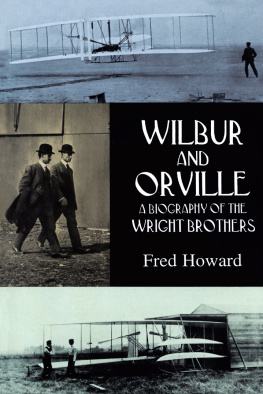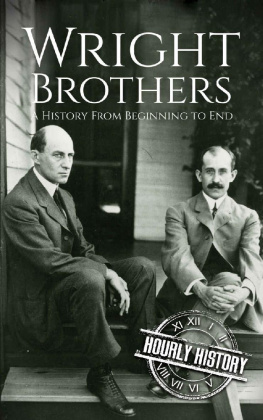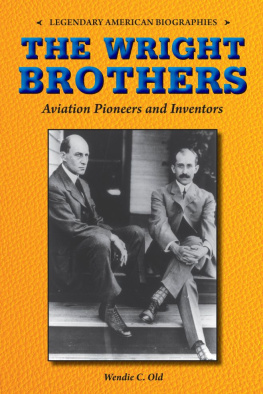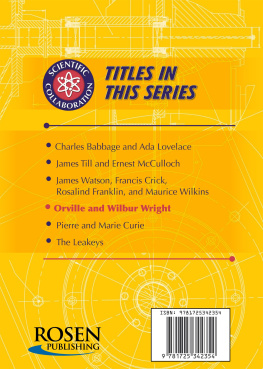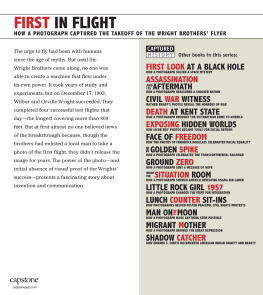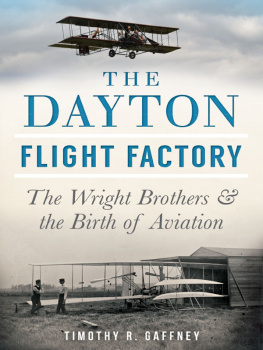W ILBUR
AND
O RVILLE
A Biography of the Wright Brothers
Fred Howard
DOVER PUBLICATIONS, INC.
Mineola, New York
Copyright
Copyright 1987, 1998 by Fred Howard
All rights reserved.
Bibliographical Note
This Dover edition, first printed in 1998, is a corrected, unabridged republication of the work originally published in 1988 by Ballantine Books, Inc., New York. It contains a new preface by the author written especially for this Dover edition.
Library of Congress Cataloging-in-Publication Data
Howard, Fred, 1910
Wilbur and Orville : a biography of the Wright Brothers / Fred Howard.
p. cm.
Originally published: New York : Ballantine Books, 1988.
Contains a new preface by the author written especially for this Dover editionT.p. verso.
Includes bibliographical references and index.
ISBN 0-486-40297-5 (pbk.)
1. Wright, Wilbur, 18671912. 2. Wright, Orville, 18711948.
3. AeronauticsUnited StatesBiography. I. Title.
TL540.W7H69 1998
629.13'0092'2dc21
[b]
9822329
CIP
Manufactured in the United States by Courier Corporation
40297504
www.doverpublications.com
Contents
Photographic inserts of 8 pages each will be found following pages .
Preface to the Dover Edition
It would be presumptuous to call this 1998 edition of Wilbur and Orville a revised edition, yet it is more than an unaltered reprint of the original. In addition to a score of corrected dates, misspellings, and inevitable typos, more than thirty textual changes have been made, very few of them detectable except to a Wright specialist with a green eyeshade, unlimited patience, and a magnifying glass. For several of these textual changes, I am indebted to a book published two years after Wilbur and OrvilleThe Bishops Boys: A Life of Wilbur and Orville Wright, by Tom D. Crouch of the National Air and Space Museum. Crouch had reviewed Wilbur and Orville in a 1987 issue of Air and Space magazine. In the final paragraph of his review, he posed a series of questions:
In spite of the authors best efforts, however, our most fundamental questions remain unanswered: Why did Wilbur and Orville succeed where so many others had failed? What manner of men were they, and what forces shaped them? Why does controversy continue to swirl around them?
I found that quartet of questions troubling, having assumed, naively, that they had been answered more or less adequately in Wilbur and Orville. Then in 1989 The Bishops Boys appeared and it became clear that Crouch had intended to answer those questions himself. His third question (what shaped the Wrights?) is answered at great length in The Bishops Boys, which is the most family-oriented of all Wright biographies, thanks to Crouchs special knowledge of the Wright family, its antecedents, and its doings. He convincingly attributes the brothers relentless pursuit of infringers of their airplane patent to their father, Bishop Milton Wright, whose penchant for taking straying members of his denomination to court set an example for his sons.
Among the half dozen or so non-biographical books on the Wrights published during the last ten years, the most important is Visions of a Flying Machine: The Wright Brothers and the Process of Invention, by Peter L. Jakab. Jakab, like Crouch, is on the staff of the National Air and Space Museum. His book is a technical study of the evolution of the worlds first airplane, from the Wright kite model of 1899 to the famed first Flyer of 1903. It answers in depth Crouchs first question: Why did Wilbur and Orville succeed where so many others had failed?
Visions of Flight appeared in 1990. Published that same year was Kitty Hawk and Beyond: The Wright Brothers and the Early Years of Aviation: A Photographic History by Ronald R. Geibert and Patrick B. Nolan, illustrated with photos from the Wright State University Archives and Special Collections. The following year saw the publication of Russell Freedmans The Wright Brothers: How They Invented the Airplane, a photobiography, primarily for young readers, with large clear reproductions of many of the Wright photos.
By the mid-1990s, it seemed that almost nothing new remained to be discovered or written about the Wright brothers. Even their pre-airplane careers as printers had been exhaustively examined in a 1988 issue of Printing History (Wright & Wright, Printers by Charlotte and August Brunsman). Then in 1995 the Wright story was retold from still another perspectivethat of a native North Carolinian.
In First in Flight: The Wright Brothers in North Carolina, Stephen Kirk has ferreted out every bit of information about the brothers half dozen excursions to the Outer Banks, the people they met there, and what happened to those people over the years. Kirks title, like the FIRST IN FLIGHT on North Carolina license plates, is guaranteed to raise the blood pressure of Daytonians, who believe that the airplane was invented entirely in Ohio.
ENGINEERS OR SCIENTISTS?
I have one small bone to pick with Tom Crouch and Peter Jakab. Engineering was the key, Crouch writes in The Bishops Boys. The Wrights functioned as engineers, not as scientists. In Visions of Flight, Jakab is even more insistent. Distinguishing between an engineering approach and a scientific approach, he points out, enables us to comprehend Wilbur and Orvilles creative processes. The importance of understanding their strict and skillful engineering approach, he reminds readers, cannot be overemphasized. He contrasts the brothers refined engineering style, their keen engineering technique to the working methods of other flight experimenters. Their wind tunnel experiments demonstrated their brilliance as engineers.
Never having thought of the Wright brothers as either engineers or scientists, I find this distinction somewhat puzzlingunless it is meant to serve as a corrective to the use of scientific in such expressions as their scientific approach to the problem of flight, or its use in the original Smithsonian label describing the Wright 1903 airplane. That label, reprinted in its entirety on the last two pages of The Bishops Boys, includes this sentence:
BY ORIGINAL SCIENTIFIC RESEARCH THE WRIGHT BROTHERS DISCOVERED THE PRINCIPLES OF HUMAN FLIGHT
The case for the use of the adjective scientific in this connection is made more explicit by Marvin McFarland, editor of The Papers of Wilbur and Orville Wright. In his Introduction, McFarland states that the publication of those two volumes realizes the often expressed intent of Wilbur and Orville Wright to give to the world a full unvarnished account of their work, especially of their original scientific investigations as distinct from their merely technical accomplishments. Orville Wright himself made it quite clear that scientific investigations referred to the Wright brothers wind tunnel experiments, when he revised the 1939 label on a reproduction of their original wind tunnel to read:
In their scientific approach to the problem of flight they devised, in 1901, the first wind tunnel and balances giving results sufficiently accurate to be of use in designing aircraft.
The Wright brothers most important work was done in the less semantically correct first decade of the twentieth century. It would be as pointless to call them great engineers as to number them among the centurys notable scientists. Why not just admit that what Wilbur and Orville achieved defies categorization and let it go at that?
Preface to the 1987 Edition
THE FIRST TIME I remember giving more than a passing thought to the Wright brothers was on a sunny November morning during World War II in the nose of a B-24 bomber. We were flying north along the Atlantic coast on the last leg of a radar practice mission. One radar student sat in a curtained booth behind the pilots compartment and navigated by comparing the standard aeronautical chart with the uncertain image on the small circular radar screen. A second student rode in the bombardiers compartment and kept an accurate navigation log as a check. On the primitive radar screen of that day the Outer Banks above Cape Hatteras must have looked like nothing so much as a glittering thread of spittle, but from the nose of the noisy four-engine bomber they were sharply etched against the deep blue of the ocean and the lighter blue of Pamlico Sound. They widened out slightly above Oregon Inlet. When they reached the white dot on the map labeled Kitty Hawk, the Outer Banks blossomed into Albemarle Sound like a bulbous nose.
Next page
